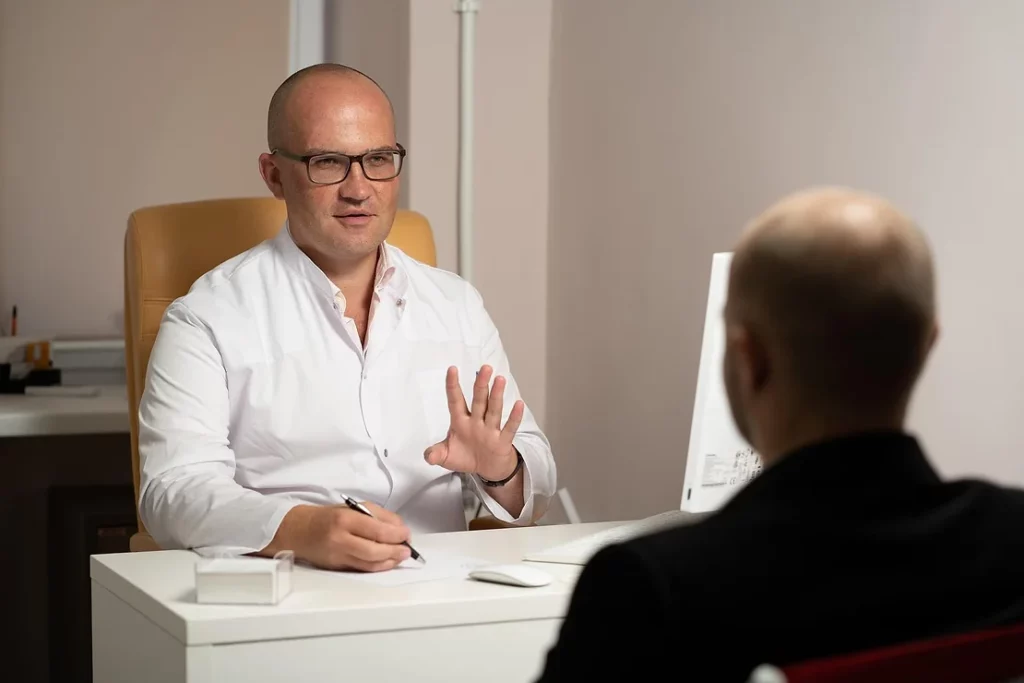Semen quality is not about masculinity. Unfortunately, a lot of men struggle with low semen quality these days. So, what can we do to help improve semen quality naturally?

In addition to vitamins and minerals, there are many other substances that have fertility promoting effects. Some of them include fenugreek seeds; tribulus terrestris, which increases semen viability; astaxanthin; Indian ginseng, also known as Ashwagandh;, aloe vera; royal jelly; cinnamon; green tea; red wine; brown beer; or dark chocolate. I am testing the last three, however, strictly in the recommended quantities. I strongly believe in them!
When it comes to male fertility, we talk about a lot of things that we need to give up, such as cigarettes, alcohol, or caffeine, and that we need to develop a healthy relationship with physical activity. We also have to consider lifestyle changes that are not easy to make for everyone. But what about changing our diet and choosing the right foods? We can find plenty of articles about nutrition and how it affects male fertility. It is easy to get lost in the abundance of information, and find out which suggestions have scientific proof to support it.
Simply put, sperm develops and matures within three months. With certain lifestyle changes, we can often achieve improvements to semen quality. However, it must be emphasized that these changes can improve semen quality, but that does not guarantee that a couple's fertility will increase, too. There are many parameters evaluated in the spermiogram, among others: the sperm count, the sperm shape, and the sperm motility. Another essential factor for healthy sperm is the energy to achieve their goal.
The good news is that there are plenty of simple things we can do to help improve our fertility health. So what can we do?
Drink plenty of plain water every day - at least 2 liters. I filled up a one-liter bottle with water and kept it with me at all times. I drank the first bottle before 11am, the second bottle by 3pm, and the last one before 7pm. It was a struggle in the beginning, but I got used to it in just one week and was able to keep up my good habit.
To positively influence semen quality, I also started making changes to my diet. The only recommendation that can currently be made to the general male population is to adhere to a healthy dietary pattern rich in plant-based foods such as in a Mediterranean diet; to reduce dairy consumption; and to give up processed foods (including salami and sausages, which I love). However, the good news is that one can eat a lot of seafood and fish due to their high content of omega-3 fatty acids.
A balanced diet is one of the most important factors for a healthy lifestyle. Extreme diets should be avoided; both low carb and high protein diets can hurt the semen quality - right now is not the time to go to any extremes!
Research has shown that free radicals may cause a decrease in semen quality, so the consumption of antioxidants, such as vitamin C, vitamin E, selenium, coenzyme Q-10, or L-carnitine, may help as well. The optimal intake of the following vitamins and minerals is the key to semen quality improvement:
- Zinc: the “fertility mineral”. It is one of the cornerstones of male fertility because it raises semen concentration, motility and testosterone levels. Natural sources include seafood, beef, lamb, chicken, nuts, legumes
- Selenium: an antioxidant that can improve semen concentration and motility. Natural sources include meat, sea fish, spinach, cabbage, mushrooms, beans, tomatoes, whole grains.
- Omega-3: essential fatty acids. They help with semen concentration, count, motility and improve its morphology. Natural Source include fish, shellfish.
- Vitamin C: an antioxidant. It improves almost all semen parameters. Natural sources include cabbage, broccoli, Brussels sprouts, cauliflower, parsley, paprika, radish, spinach, papaya, citrus fruits, strawberries, kiwi, black currant.
- B-9: Folate, the natural form of B9, also called folic acid in a synthetic form, promotes semen production, and is essential for DNA synthesis. Natural sources include legumes, eggs, nuts, green leafy vegetables, and ginger.
- B-12: Natural sources include beef, chicken, liver, salmon, tuna, eggs, seeds, cracklings, bananas.
- Vitamin E: an antioxidant. Natural sources include almonds, pumpkin seeds, sunflower seeds, sesame seeds, green leafy vegetables, vegetable oils, and avocado.
- Calcium: Natural sources include salmon, chia seeds, sardines, almonds, dark leafy vegetables, dried figs, oatmeal.
We can choose between natural sources that contain these minerals and vitamins but where exact quantities are unknown. Or we can opt for vitamin and mineral supplements that we can regularly consume in individual recommended quantities. Whichever route you choose, it's always a good idea to consult with your physician or fertility specialist to decide upon the right kinds and amounts. To make my (and my wife’s) life easier, I made a list of cooking ingredients to boost fertility and I tried to integrate as many of them into my daily diet as possible.
The system of fertility programs, based on my own experience, takes men as side characters. No problem at all, bad systems are there to break them
Did you know what ‘infertility’ means? The definition is very simple: if a couple has unprotected sex for 12 months and they are not able to conceive, they are labelled as infertile. I was sincerely surprised by this simple definition.
Unfortunately, most people still identify infertility as a ‘woman problem’. Although if we check on the main causes of infertility, we can find it easily that nothing can be further from the truth. For me, the turning point definitely was, when it turned out that - based on my spermiogram - I was an active participant in our lack of success. Before that I supported actively my wife, but then it became a completely different story. Even though if you have award-winning sperm quality, you still need to participate in the program with the same dedication as if it were all up to you.

"Don’t wait to be asked for staring in the movie. This is not Hollywood. It’s simply one, if not the most important movie of your life."
When I found myself in the world of IVF, I had to face the fact that everything is apparently all about the woman. In this story I felt like a “supporting family member”. There are a lot more tests and examination on her, some of them can be painful (fallopian test), and she even has to undergo a surgery (egg retrieval). These are the physical parts of the fertility program. I can’t take the hormones, or go under a surgery instead of her, even though I would do it happily. But there are many situations where I can make my partner’s job easier with my presence and support.
I don’t want to be a passive character in the story. I would like to have a child with her, such as much as she wants it. I can never leave her alone under any circumstances. I always want to be there for her, and make her feel, she can count on me. It’s also true if I play a more active role, I can own the process much more as well. It already makes an enormous difference when instead of saying ‘we have to undergo fertility treatment because my wife cannot have a child naturally’, I take it as ‘we, as a couple’ have fertility problems.
Your partner will need a constant emotional support. She is going to go through so many challenges over the process. Don’t be surprised if she laughs when she supposed to feel sad, and the other way around, and it won’t be the weirdest situation believe me. During these difficult weeks, you will be her rock, because you have to be.
The system of fertility programs, based on my own experience, takes men as side characters. No problem at all, bad systems are there to break them, it doesn’t have to be, work this way. Feel free to be more active in the process, first of all it will make your partner happy, and secondly you will be proud of yourself. Believe me, this will be very much needed too.
During our first IVF attempt, we came across a lot of new terminology and information in a very short time, and it was quite challenging to take it all in. We were very familiar with some of the information that was given to us, and slightly less familiar with some of the more technical terms and procedures. By all means, a lot of material was completely new to me, even though I attended biology classes at school, but there may be a slight chance that I did not pay enough attention. Live and learn! There is no shame in having a little refreshment course.

It can be very beneficial to have a better understanding of what is happening in our bodies and reproductive system, so here are some basics that we all should be familiar with. Let’s start with the ladies!
Ovaries: they are small, almond shaped glands, and primary female reproductive organs. They are located on either side of the uterus, at the end of each fallopian tube. The ovaries have three main functions: they produce and store all the eggs a female is born with; they produce female hormones estrogen and progesterone; the ovaries release, usually, one egg during each menstrual cycle for fertilisation.
Follicle: a follicle is a small fluid-filled sac located in the ovaries that contains a developing egg. During each menstrual cycle, several follicles begin the maturation process. However, usually only one of the follicles reaches maturity and becomes dominant. Later on, this follicle is selected to grow until it is ready to release the egg, which is ready for fertilisation.
Egg: also called ovum, is the female reproductive cell. The eggs are located inside of the follicles in the ovaries. Interesting fact is that females are born with all of their eggs that they will have during their lifetime. Their initial number reaches hundreds of thousands, but drops to about 200,000 by adolescence, and continues to decrease with age. The egg is the largest human cell, and measures about 0.1 - 0.2 mm in diameter. During ovulation, the egg leaves the follicle and enters the fallopian tube where it awaits fertilisation.
Fallopian tubes: also called uterine tubes, are two narrow, 10-12 cm long ducts that connect the ovaries to the uterus. They have three main functions: they transport the male sperm cells towards the egg, which is waiting for fertilisation in the tube; they provide suitable environment for the process of fertilisation; they transport the egg from the ovary to the uterus. If the fallopian tubes are blocked, an egg cannot meet the sperm, fertilisation cannot take place and pregnancy will not occur.
Ovulation: when a follicle ruptures, the egg is released from one of the ovaries. It typically happens around day 14 of the menstrual cycle. The eggs have quite a short lifespan and are viable only for 12-24 hours. Sperm remain viable for several days inside of the female reproductive tract, therefore 3 days prior to ovulation and 2 days after ovulation are considered the most fertile days for females. This is also called a fertility window, which is a term used very often in the IVF community. During the actual IVF process, ovulation is regulated by hormones.
Menstrual cycle: it is a series of natural changes in hormone production and the structures of the uterus and ovaries. These hormonal changes make it possible for a pregnancy to occur. There are four phases of the menstrual cycle: menstruation, follicular phase, ovulation and the luteal phase. The average menstrual cycle is 24 to 38 days long, however, some women may experience irregular cycles that last shorter or longer amount of time. The first day of the menstrual cycle is the first day of menstrual bleeding, also called a period, which typically lasts 4 to 8 days.
Now that we have covered the ladies, let’s move on to the men!
Spermatogenesis: it is the process of producing and developing sperm. It is a 74 day long cycle during which germ cells, male reproductive cells, develop into sperm with the ability of independent movement and fertilisation. Male testicles produce several million sperm per day!
Sperm: sperm is the male reproductive cell. Some people may use these two words interchangeably, yet, sperm and semen are two different terms; semen is a fluid, which contains sperm, but it only makes up only 5% of the weight of the semen. Sperm cells are very tiny, measuring only 50 micrometers from head to tail. A sperm can travel about 3 mm per minute, and it is viable and capable of fertilisation for 30-50 hours after ejaculation. However, 90% of the sperm in a man’s ejaculate are deformed; they can be misshaped, have a small or large head, or no tail. Just a small percentage of sperm are actually able to fertilise an egg.
Sperm count: it is a measure of the number of sperm in each ejaculation. A normal sperm count ranges from 15 million to 200 million per millilitre of semen. Low sperm count is considered when there are less than 15 million sperm per millilitre, or less than 39 million sperm per ejaculate. This phenomenon is refer to as oligospermia and it affects one in every six couples. Unfortunately, it has been a very serious issue in many developed countries in the last few decades.
Sperm motility: this refers to the ability of sperm to move forward and progress for at least 25 micrometers per second. A sperm analysis examines how many of the sperm are motile. The higher the number, the better. It has been debated for many years that sperm with Y chromosomes, or the “boy” sperm, can swim faster than sperm with X chromosomes, known as the “girl” sperm. However, it has been proven to be a myth.
Sperm morphology: the semen analysis test examines sperm morphology, which refers to the size, shape and overall appearance of a man’s sperm. The results are shown as a percentage of sperm that appear normal. Sperm are examined in order to evaluate male fertility, because the egg can only be penetrated by sperm that have a “normal” shape. Interestingly enough, this will be a fairly low number since many sperm have an abnormal shape. The good news is that there are millions of them and only one is needed to fertilise the egg.
It’s time to take our part of the fertility journey: let’s boost the little guys.
There are very few men left on the planet who don't need any help to boost their fertility. I am not one of them, so I decided to do as much as possible to improve my sperms’ health. I am going to have very little to do during our IVF program compared to my wife, so this is the least I can do to increase our chance of success.

"With any positive changes, we can do a lot to consciously improve our fertility."
Let’s continue to learn more factors which can affect the health of our sperms and male fertility.
- Ideal weight: Both too much and too little fat have a negative effect on hormone production, and sperm health and count. Moreover, in overweight men, fat pads warm the testicles, and as we learned, sperms don’t like heat. Weight is something that we cannot change overnight. Making a significant and healthy change on it, can take months (sometimes even years). Losing or gaining weight should be part of a well-planned preparation. I have 4-5kg extra weight on me, and it is impossible to lose (in a healthy way) in 4 weeks (at least for me).
- Caffeine: The most popular stimulant. That's how I start the day every morning. But keep in mind that energy drinks and cola also contain caffeine. Funnily caffeine can be a double-sharp weapon. In a small amount it stimulates sperm production in small amounts. Great news! However, in larger quantities, it can be one of the causes of sperm deterioration, and also can reduce its quantity. Another important fact that is important to remember, that beverages that contain caffeine, have diuretic effects and may cause dehydration, which is not good at all when we try to conceive. I am a coffee lover but fortunately I am not a big fan of energy and soft drinks. So, it will be easy for me to be a good boy on this.
- Exercise: Sport is one of the best things in the world if you do it within normal limits. It relieves tension (so you can reduce stress), creates good conditions, and makes you balanced. It can help you reach your ideal weight as well. But you don't want to be Schwarzenegger for now. Do not touch anabolic steroids, muscle and weight gainers. Firstly, your testicle can get smaller (you will look stupid), secondly, you can even reset your sperm count with them.
- Toxins: Unfortunately, improper nutrition already delivers a lot of toxins into our bodies. We can come into contact with many toxins at work and home (solvents, cleaners, pesticides) as well. Try to avoid them if it is not possible, or at least use appropriate protective equipment.
Obviously, there are many things listed above that are difficult to change. These are just some important factors – at least - to be aware of. With any positive changes we can do a lot to consciously improve our fertility. And if we were “accidentally” keeping these lifestyle changes for the long term and living healthier by the way, we could hold not only our own child, but hopefully even our grandchildren in our hands. Is it enough motivation? Is there more motivation than that?
How you can improve sperm quality and quantity with some changes in your daily life and habits. Beware, you might notice positive changes in other areas of your life as well.
If you are like me, you never really paid attention to your sperms (I mean in a scientific way). It completely changed when I received my sperm analysis result, and it’s not too great a number. I felt like it’s time to learn more about them (especially when it comes to their parameters).

"Studies show that a smoker has 15% less sperms compared to a non-smoker, and more lazy sperms with abnormal shape."
I read about many factors which can cause sperms with abnormal shape, not enough quantity or pure concentration. BUT I also learned that actually there are many things that I can do, and make improvements on these parameters. These are mainly lifestyle changes, and most of them don't cost too much, I just need to pay a bit more attention and be willing to change.
- Smoking: I was a heavy smoker for 15 years, but I quit 15 years ago though. I know exactly how hard quitting is. (This is not the easiest lifestyle change, I know, but I wanted to start with the most difficult one.) BUT you have to know smoking has a huge negative impact on the quality and quantity of your sperms. The problem is mainly caused by the nicotine (so electric cigarettes are not really an option either). Studies show that a smoker has 15% less sperms compared to a non-smoker, and more lazy sperms with abnormal shape. SMOKING + ABNORMAL SHAPE + LAZY SPERM = NOT IDEAL!
- Alcohol: At this point I started to be worried a bit (I love red wine). Actually, I don’t have to be abstinent (a big release!), I just have to be careful with the quantity. 2-3 glasses of wine or beer weekly won’t do a huge harm on my sperms. A bigger dosage of alcohol would lower the chances of my boys, because they can have an abnormal shape and a smaller army in numbers. It sounds doable to me.
- Drugs: I cannot share any personal experience about this point, but what I learn for sure: they don’t do any good for our hormones. They can reduce our testosterone level, have a negative effect on the shape of sperm, and the sperms go nuts (as you do) if you are on drugs (I don’t know what does it mean exactly, they might move too fast?).
- Heat: It never even would cross my mind. Using my laptop on my laps, or enjoying the comfort of the seat heating in the car actually can overheat my sperms. They don’t need too much heat as they are super sensitive. If they get some extra, unwanted heat on their outer layer, it’s enough for them to die. Riding a bicycle, spending time in a sauna can also cause extra heat. It is also better to switch from hot baths to showers for the health of our sperms. I think here I am going to face some difficulties (laptop usage, love of hot baths and bicycling).
- Stress: I know, it’s easy to say, do not stress these days. At least be aware that too much stress has a huge negative impact on every area of your life. Speaking about sperms: it decreases the concentration, makes them lazy, and will affect the shape as well. So, just take it easy!
There are still a few possible lifestyle changes I would like to share with you in my next articles, but I find it easier to take these changes step by step.
More and more men are affected by fertility problems. Why is this topic not spoken more about?
To make it short, on the second consultation, we got the green light from the doctor to go for IVF, as our only one chance of having a baby. Actually, the plan was that in a week or so, we will start our fertility treatment.

"It never crossed my mind before how much I can do to improve my reproductive health. To be honest, it did not cross my mind either that I have to do anything for it."
As you could read in my previous article, I am going to face our first IVF cycle with my ‘not too tragic’ but ‘not great at all’ semen analysis result. After the stage of ‘Unbelievable’, I entered the phase of ‘Acceptance’, then I started to think about how I can improve my result.
I dived into the world of ART (Artificial Reproductive Treatments), and came across my new favorite word: fertility awareness. We hear about many different awareness and consciousness, but the term ‘fertility awareness’ was completely new for me. It never crossed my mind before how much I can do to improve my reproductive health. To be honest, it did not cross my mind either that I have to do anything for it.
Fortunately, the sperm production is continuous in our body, and takes approximately 3 months to create a completely new army. It means that with some changes in our diet, lifestyle, and habits, we can do a lot for sperm who will be formed in the future. Of course, this cannot happen overnight. It takes about 3 months to notice significant improvement on the result.
Unfortunately, in my case, I had too little information about this topic, and too little time left for big improvement or to correct my bad result. But, of course, it didn’t discourage me to start some changes, because – I believe - every journey starts with one step.
It would be great if this information wouldn’t reach only those couples who are already participating in IVF programs. It’s scary to read that there’s a tendency for men’s fertility to deteriorate from decade to decade, and moreover, typically, men don’t like to test and face it. How much easier it would be to avoid a lot of setbacks, stress and sometimes relationship problems that come with fertility failures. Fertility awareness is all about avoiding these above.
Edit: Our IVF cycle is postponed, because a little miracle happened. Who knows how, but we were able to conceive naturally. We had a chemical pregnancy, meaning that one of my sperm was able to fertilize an egg naturally, but unfortunately the implantation was not successful. This is proof: we can do it! ☺ We have to wait a month to start our fertility treatment, which also means that I gained an extra month to improve (even a bit) my sperm condition.
How I learned that sperm analysis isn’t about getting a certificate about my fertility superbness, but showing me there’s room for improvement.
On the next consultation with our doctor, unfortunately it became official, which was only my guess until then: the result of my semen analysis is – let’s say - not ’the best’. The doctor pronounced it clearly: I am involved in our fertility journey as much as my wife is. I am the other 50% in the formula, and the reason why IVF is our only way of having a child together. It didn’t break me, but it was not a comfortable feeling either. I needed some time to digest the situation. I read a few studies about the fact that male fertility has become a bigger problem these days than female fertility. Most of the studies say that minimum 30% (some of them say up to 50%) of infertility problems come from the male side. Studies also show that men’s sperm count dropped, and the capability of fertilization decreased drastically (to its half) over the last few decades in Europe. It surprises me, because if it’s really such a big, common problem, why don't we speak / know more about this?! Knowing that I am definitely not alone with this problem helps me put my mind to ease but it still bugs my ego.
Anyway, let's see what a sperm analysis is about, and my result?

"Most of the studies say that minimum 30% (some of them say up to 50%) of infertility problems come from the male side."
- During the test, they measure the volume of the semen. The normal parameter is 1.5-6 ml (I had 5 ml, so I was OK with this part). This factor is important to show us how big our army will be to start with.
- They also check on its pH. The ideal value is 7.2 (slightly alkaline), but it is considered normal between 7.2-7.8. (Mine was 8.)
- They also check on the motility of the sperms, which is significant because they have to take a long way to reach their goal. If we calculate from the total sperm count, at least half of the little fighters should have good movement. In my case, the progressive motility (when the sperms move in a straight line along a large-arc circle) was 50% (this is ideal). My non-progressive motility value (when sperm moves along a small-arc circle) was 5%. 50% + 5% = 55% in total (which is ok!). I’ve never been a great dancer, but at least my spears are moving well.
- Sperm concentration and sperm count are also determined. Sperm concentration shows how many sperm are present in 1 ml of semen, and sperm count shows the total number in the whole ejaculation. These indicators are changing so mournfully, that an acceptable normal minimum value is no longer even set. The WHO (World Health Organization) has recently given the normal values at 15 million / ml and 39 million / sample. I had 10 million / ml and 50 million / ejaculation, which are not particularly good values.
- They also examine the morphology of the sperms (if the sperm head is in the right shape or size). The sperm head, for example, plays an important role in breaking through the egg wall to be able to fertilize it. According to the WHO numbers, at least 4% of the sperms should be in formal order (unfortunately, this was only 2% for me). Interestingly, I also came across a study that showed that 29% of men with 0% normal-shaped sperm were able to fertilize an egg in the natural way (not with IVF). So, sperms with abnormal head shape doesn’t mean that there’s any genetic problem with them.
The official diagnosis of seeing all my numbers together was: oligo-teratozoospermia. Meaning I have reduced sperm count and low sperm motility.
However, there is a significant advantage for men over women. While the number of eggs is given at birth, and from then this number decreases and then runs out, in men the sperms are renewed cyclically. The process of sperm formation (spermatogenesis) takes 74 days. (Because we cannot know which part of this cycle we are in, it is better to calculate with 3 months). Meaning: in most cases, men have a chance to improve their ‘sperm situation’ in three months.
A normal reaction of a healthy man: Is everything fine with me or not?
As I mentioned before, our IVF specialist didn’t give me too many things to do. The doctor gave me referrals for a blood test and the semen analysis. Two tests only, which compared to my wife’s list, was nothing.

"I won’t lie: the result hit me hard, and it was almost unbelievable for me."
Blood tests are needed for men to know if they don’t have any infectious diseases, such as HIV, hepatitis, HPV, syphilis, etc. It’s just a normal blood test, easy, nothing to worry about.
I didn’t make a big deal about the sperm test either. I knew that everything was fine with me. My confidence was based on a very strong fact. At the age of 47, I am a father to three amazing, healthy, smart, beautiful girls. I don’t need better evidence, that I am the masterpiece of creation. I couldn't see why I could not do what I have done 23, 19 and 10 years ago. (Of course, it did not even cross my mind that many years passed.) So, I was absolutely ready for testing.
The semen or sperm analysis needed a bit of preparation. The instruction was “3-7 days abstinence”. Doing a bit research, I found that not having sex for 4-5 days can bring us the best result (if you keep the guys inside longer or shorter it can affect negatively the result). Cheating is not allowed either (you know what I mean, when no one can see you). You have to remember these rules when giving the sample for the fertilization later as well.
My wife asked me to drink plenty of water for one week prior to the test. We all know drinking enough water is essential to keep our organs, and cells functioning properly. So, it makes sense that it has the same effect on our reproductive cells: the sperms. Semen production can be reduced by not drinking enough water and causing dehydration; the semen can get thicker, and the sperms may have trouble swimming. I increased my water intake to 3 liters per day.
The day the big test arrived. I proudly produced the sample for the semen analysis as the doctor asked me to do, and I was waiting for the result without any fear or worry.
The next day I received my result via email. My numbers were not exactly what I hoped for. I jumped on my laptop, hoping that my best friend Google would help me out and I would find written evidence that my numbers might not be great but at least acceptable. “Every man kindles the fire below his own pot”, so do I. I started to create my own explanations: it’s not even so bad, it's just ‘sometimes’ a bit different than the normal numbers. The room at the Clinic was not the most ideal environment for this kind of activity either, and it must have had an effect on the result as well. If you would have been there, you would know what I mean…
I won’t lie: the result hit me hard, and it was almost unbelievable for me. On one hand, I tried to accept it, but on the other hand, I really hoped the doctor would tell me that my result is not as bad as it looks.
This was the day when the world of IVF grabbed me. I still tried to believe that everything is fine with me, and that the doctor would tell me something that can put my ego back into the ‘masterpiece of creation’ stage. But deep down, I knew that it is not only about ‘my wife’s issue’ anymore, but about mine as well. This was one more thing that would make us stronger.
One thing you should know from the beginning, is how much your wife is going to do for your future baby.
We decided who is going to be our fertility specialist. We considered a few factors, but I think it’s pretty normal that the final decision was my wife’s. We chose a specialist who was recommended by her gynaecologist. After the first consultation with him, it was obvious that the treatment would be heavier on my wife, than on me. I was asked to take two tests only: a blood work, and the famous semen analysis, which compared to my wife’s list, was nothing. I think the best way to use my time and energy is to support her, and be there for her if she needs me.

"She was in so much pain from the pressure on her blocked tubes, that I could hear her yelling at the waiting room. "
It was evident that, if she wants, I am going to accompany her to all the appointments she has to go to. This is a real couple-goal. I want her to feel that we are doing this together. Support is always a good way to show you care, even if most of the time I cannot do anything else then just sit in the waiting room, and drive to and back home from the clinic.
So, today I was a driver again, and took her to the gynaecologist for HyCoSy. The doctor ordered her to take a new fallopian tube examination. Depending on this exam, we will know if we should/can go for IUI (intra-uterine insemination) or IVF. Fallopian tubes and their function is important because they lead the eggs to the womb, and it is also the place where the big meeting with the sperm happens. If the fallopian tubes are blocked, it’s impossible, and also can cause further complications.
Of course, I wanted to know a little bit more about this exam. The procedure is not too complicated. The doctor is going to inject some contrast fluid into the womb, and check by ultrasound the fluid's path journey. If the ultrasound can show the fluid passing through the tubes, it means the fallopians are clear, if not, it means they are blocked. If the tubes function well, the examination process is almost painless (they say), but if they don’t it can be painful. So, I am really worried for her, as our last information is that both her tubes are blocked.
Based on my research, I found something which gave some hope. It can happen during the examination process that from the pressure of the liquid the fallopian tubes become unblocked. Actually, one of my friends got pregnant right after HyCoSy, never before and never since then. Understandably, I had mixed feelings about the appointment.
To make it short: my wife is a superhero. She was in so much pain from the pressure on her blocked tubes, that I could hear her yelling at the waiting room. The good news: that the pain didn’t last, so she was completely fine when we left the clinic. The bad news: both of her tubes are completely blocked, so it’s more likely that our only one way of having a child is going for IVF.
What basic steps you will face during IVF.
After I had to omit my first plan – solving our problem in house, ‘in vivo’ instead of ‘in vitro’ – failed, and acknowledged that we are going to need medical help, I started to learn about IVF treatments. I think all of us have some idea about what it is. Everyone has a friend, family member, or a colleague who has some experience in this field (but it’s true, it isn’t something we would discuss over a beer). These days it’s also common to hear about celebrities undergoing fertility treatments as well. Meaning: IVF became an accepted way of making a baby. Even though everyone prefers to have a child in the normal (and much more fun) way, unfortunately it’s not as easy for everyone.

"Everyone has a friend, family member, or a colleague who has some experience in this field (but it’s true, it isn’t something we would discuss over a beer). "
So, here are the basics which (even) a man should know about fertility & IVF.
- Hopefully everyone knows how to conceive naturally. In the middle of the woman’s menstruation cycle, her ovary releases an egg. The egg (also called ovum) starts to travel through the fallopian tube in the direction of the womb. During this trip the egg meets the sperm, and if they meet at the right time and like each other, the magic might happen. The fertilized egg continues its journey to the womb, where it develops into an embryo and is going to implant into the uterus lining. BOOM! Simple as 1x1.
But ‘in vitro’ it’s not as simple:
- The IVF treatment is going to start the 2nd day of your partner’s period, and actually everything will be scheduled around her menstrual cycle.
- In a normal month (without IVF) a woman releases only 1 egg per cycle. In IVF we need more eggs. This is possible with hormone stimulation, that’s why your partner is going to need the hormone injections. Be very proud of her, because we all know how a man can react to pain.
- The stimulation process is controlled by the doctor regularly (it’s not lucky to have under- or overstimulation either). The doctor checks on the follicles with an ultrasound test. The stimulation phase takes approximately 10-12 days, depending on how her body reacts to the hormones.
- When the follicles look matured enough, your partner has to go under a minor surgery. It’s called egg retrieval, or egg collection. The doctor is going to poke all the follicles and collect the eggs from all of them. This is a very low risk surgery, so nothing to worry about, but again: it won’t be performed on you, so be supportive!
- At the same time of the egg collection, your major, and only one job is due as well: sperm collection.
- From here, there are two different ways to go:
- The embryologist will let some of the sperms meet the eggs freely. This is approximately the same as it would happen ‘in vivo’. Or
- The embryologist will choose the best-looking sperm and help him enter the egg. It usually happens if there are not too many eggs or sperms available.
- After this, the lab keeps the fertilized eggs in an incubator for 3-5 days, depending on their development. Unfortunately, not all embryos are going to make it until Day5. It’s normal.
- Depending on the embryo-development, your doctor is going to decide the best time for embryo transfer. You are also going to have a consultation about the optimal number of transferred embryos. This is a quick and absolutely painless procedure. The doctor is going to put back the embryo(s) into your partner’s womb.
- If you are lucky to have more embryos than needed for the transfer, the remaining quantity can be frozen, and used later. It's great news, because if you have to go for more IVF cycles, your partner doesn’t have to do hormone stimulation and egg retrieval again.
- After the transfer you have to wait approximately two weeks to know if you have succeeded.
This is the IVF process in a nutshell, but I somehow have the feeling that it won’t be as simple as it sounds, but we will see.